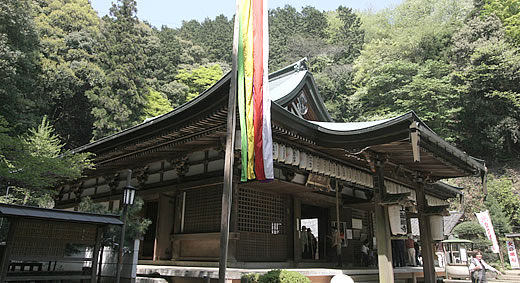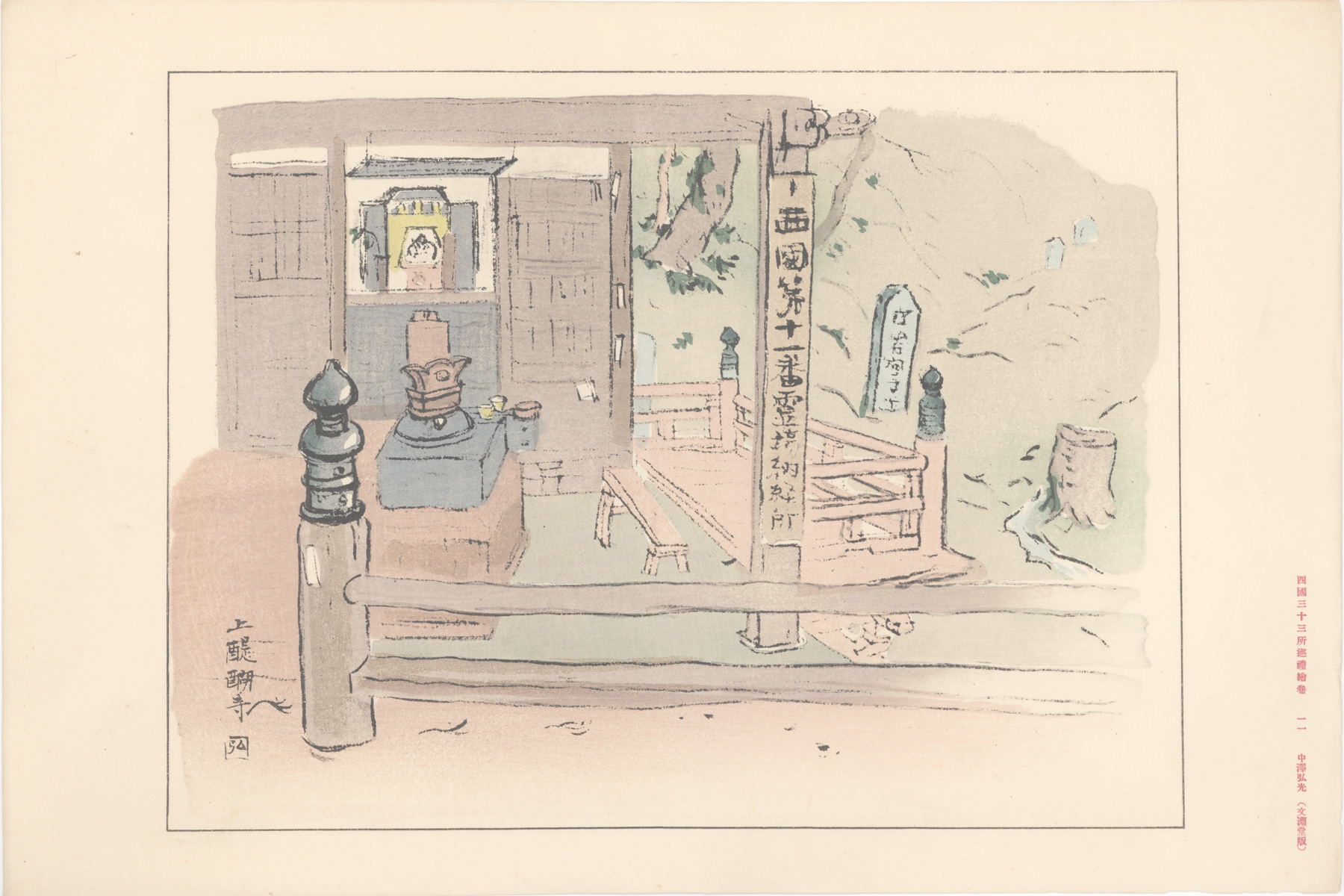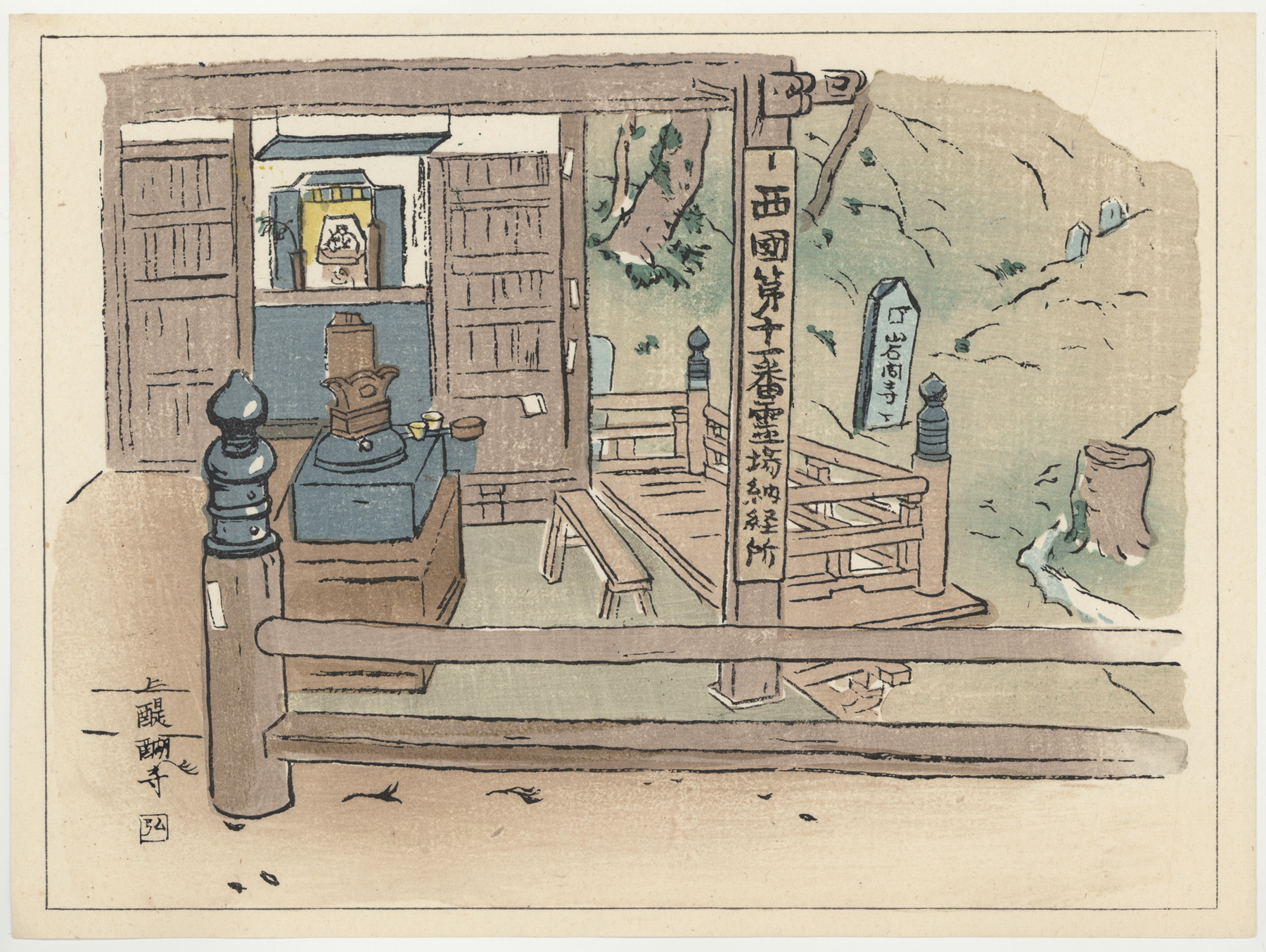About This Print
Kami Daigō-ji, a complex of some of the oldest temple buildings in Japan, is the upper precinct of Daigō-ji and is the 11th temple on the Saigoku Kannon Pilgrimage. Nakazawa presents us with a view of a shrine building with a sign on its post reading 西國第十一番靈場納経所 (Saigoku sanjūsan reijo nōkyō-sho), telling us we're visiting the eleventh sacred place on the Saigoku pilgrimage and a donation of money or a sutra can be left there. Off to the right we see a bluish stone marker leading the way to Iwama-dera 岩間寺, the 12th temple along the Saigoku Kannon Pilgrimage.
Along with his two traveling companions, the poet Ishikura Suiyō and the artist Akatsuka Chūichi, Nakazawa undertook this 600 mile pilgrimage in December 1923, only three months after the Great Kantō Earthquake devastated the Tokyo area.
For more information on their pilgrimage see the article Nakazawa Hiromitsu - Picture Album of the Thirty-Three Pilgrimage Places of the Western Provinces.
In 1994, Daigō-ji was designated a World Cultural Heritage Site.


Juntei Hall was originally built in 866. But the present building was reconstructed in 1968.
The statue of Juntei Kannon to which the hall is dedicated is usually kept hidden.
On 18th of May every year, however, the service ceremony called Gokaihi (Opening Door)
is held and the statue is opened to public for three days.
Caption and image source: https://www.daigoji.or.jp/garan/kami_garan_detail_e.html
The Saigoku Kannon Pilgrimage (Saigoku sanjūsansho junrei)
Japan's most famous pilgrimage, originating in the 11th century, encompasses 33 Buddhist temples in Western Japan (Kansai region) dedicated to Kannon (bodhisattva Avalokitasvara), the Bodhisattva of Compassion, who hears the cries of the world and assists anyone in distress.
The 33 temples on the approximately 1,000 kilometer pilgrimage route correspond to Kannon's ability to take on 33 different forms. One hundred thousand pilgrims navigate the route in its entirety or part each year.
Note: For a listing of all 33 temples go to https://en.wikipedia.org/wiki/Saigoku_Kannon_Pilgrimage. To access an interactive map of the route and its temples go to https://www.thetempleguy.org/p/saigoku-33-kannon-route.html and scroll down towards the bottom of the page.
About the "Picture Album of the Thirty-Three Pilgrimage Places of the Western Provinces"
First issued in 1925 and reprinted in 1946, the 1925 album contains 58 prints and the 1946 album 59 prints. For detailed discussion of the two editions and additional information on the Saigoku Kannon Pilgrimage see this site's article Nakazawa Hiromitsu - Picture Album of the Thirty-Three Pilgrimage Places of the Western Provinces.
Print Details
IHL Catalog
#1859 (1946 second edition) and #2413.19 (1925 first edition) Title or Description Kami Daigō-ji (temple 11)
上醍醐寺 (十一) Series Picture Album of the Thirty-Three Pilgrimage Places of the Western Provinces
西国三十三所巡礼画巻 Saigoku sanjūsansho junrei gakan Artist Nakazawa Hiromitsu (1874-1964)
Signature  IHL Cat. #2413.19 (1925 release): 中澤弘光 [Nakazawa Hiromitsu] printed in lower right margin as shown left
IHL Cat. #2413.19 (1925 release): 中澤弘光 [Nakazawa Hiromitsu] printed in lower right margin as shown left
IHL Cat. #1859 (1946 release): not signed Seal of the artist 
 弘 Hiro
弘 Hiro
left seal: IHL Cat. #2413.19 (1925 release)
right seal: IHL Cat. 1859 (1946 release) Publication Date IHL Cat. #2413.19: Published September 28, 1925 大正十四年九月十八日発行 as printed in the 1925 album's colophon (see Album Box with Print of Kannon IHL Cat. #2413).
Note: an earlier date of June 15, 1925 大正十四年六月十五日 appears in the right margin of the print titled Matsunoo-dera [IHL Cat. #2245], the only print in the 1925 album which carries a date. This earlier date, however, is the date that the censor's approval was obtained, as further explained on this site's web page for Matsunoo-dera, rather than the publishing date.
IHL Cat. #1859: January 18, 1946 昭和二十一年一月十八日発行 [Individual prints in the 1946 release are not dated. This date taken from a 1946 album colophon.]
Publisher 發行者 金尾種次郎 publisher Kanao Tanejirō
發兌元 金尾文淵堂 publishing house Kanao Bun'endō

IHL Cat. #2413.19 (1925 release): 文淵堂版 [Bun'endō han] printed in lower right margin as shown left
IHL Cat. #1859 (1946 release): no publisher seal
Carver Okada Seijirō 岡田清次郎
Note: the album's colophon (see Album Box with Print of Kannon IHL Cat. 2413) lists two carvers, the above well-known Okada Seijirō and 大倉藤太郎, possibly read Okura Tōtarō, who I can find no information on. Printer IHL Cat. #2413.19 (1925 release): Nishimura Kumakichi 西村熊吉
Note: the colophon for the 1925 album (see Album Box with Print of Kannon IHL Cat. 2413) lists three printers, the above well-known Nishmura Kumakichi; 山県秀助, possibly read Yamagata Hidesuki, who I can find no information on, and 松本兄弟堂, a company founded in Osaka by Matsumoto Kisaburō 松本喜三郎 in 1923, which I believe did the letterpress printing.
IHL Cat. #1859 (1946 release): Nishimura Kumakichi 西村熊吉 and
Takagi Seikō (Takagi Kiyomitsu?) 高木淸光
Note: the above information is taken from the colophon included in the 1946 release. I could find no information on the second printer listed for the 1946 release 高木淸光.
Note on Nishimura Kumakichi: listed as one of the printers for both the 1925 and 1946 release, there is some uncertainty about the date of his death, although a birth date, either 1861 or 1862 [Guide to Modern Japanese Woodblock Prints, Merritt, p. 223], is generally accepted. A death date of 1941 is sometimes given and 1955 has been suggested, but Merritt provides no date of death. If he truly did the printing for the 1946 release he would have been around 85 at that time.
Impression IHL Cat. #2413.19 (1925 release): excellent
IHL Cat. #1859 (1946 release): excellent Colors IHL Cat. #2413.19 (1925 release): excellent
IHL Cat. #1859 (1946 release): excellent Condition IHL Cat. #2413.19 (1925 release): good - minor damage to margins in lower right; minor handling creases
IHL Cat. #1859 (1946 release): excellent - mounting residue three place along top verso
Genre shin hanga; shasei kikō (sketch-tour) Miscellaneous temple/print number 11 appearing in the right margin of the 1925 release
Format horizontal oban
H x W Paper
IHL Cat. #2413.19 (1925 release): 10 1/8 x 15 1/4 in. (25.7 x 38.7 cm)
IHL Cat. #1859 (1946 release): 9 5/8 x 13 3/4 in. (24.4 x 34.9 cm) H x W Image
IHL Cat. #2413.19 (1925 release): 8 1/2 x 11 9/16 (21.6 x 29.4 cm)
IHL Cat. #1859 (1946 release): 8 1/2 x 11 1/2 in. (21.6 x 29.2 cm) Literature Nakazawa Hiromitsu kenkyū: Hon karano kenshō, Hiromitsu Nakazawa, Mitsunobu Satō, et. al., Mitsui Kōkei, Tokyo, 2006, p. 46-48. Collections This Print
National Diet Library Call Number 寄別7-8-2-5 (1925 album, no images displayed); National Library Board, Singapore BRN:9854371 (entire 1946 album, no images shown); British Library System number: 017018582 (entire 1946 album, no images shown); Harvard Yenching Library HOLLIS number 990082993710203941 (1925 album, no images displayed)
| IHL Catalog | #1859 (1946 second edition) and #2413.19 (1925 first edition) |
| Title or Description | Kami Daigō-ji (temple 11) 上醍醐寺 (十一) |
| Series | Picture Album of the Thirty-Three Pilgrimage Places of the Western Provinces 西国三十三所巡礼画巻 Saigoku sanjūsansho junrei gakan |
| Artist | Nakazawa Hiromitsu (1874-1964) |
| Signature |  IHL Cat. #1859 (1946 release): not signed |
| Seal of the artist |   left seal: IHL Cat. #2413.19 (1925 release) right seal: IHL Cat. 1859 (1946 release) |
| Publication Date | IHL Cat. #2413.19: Published September 28, 1925 大正十四年九月十八日発行 as printed in the 1925 album's colophon (see Album Box with Print of Kannon IHL Cat. #2413). Note: an earlier date of June 15, 1925 大正十四年六月十五日 appears in the right margin of the print titled Matsunoo-dera [IHL Cat. #2245], the only print in the 1925 album which carries a date. This earlier date, however, is the date that the censor's approval was obtained, as further explained on this site's web page for Matsunoo-dera, rather than the publishing date. IHL Cat. #1859: January 18, 1946 昭和二十一年一月十八日発行 [Individual prints in the 1946 release are not dated. This date taken from a 1946 album colophon.] |
| Publisher | 發行者 金尾種次郎 publisher Kanao Tanejirō 發兌元 金尾文淵堂 publishing house Kanao Bun'endō  IHL Cat. #2413.19 (1925 release): 文淵堂版 [Bun'endō han] printed in lower right margin as shown left IHL Cat. #1859 (1946 release): no publisher seal |
| Carver | Okada Seijirō 岡田清次郎 Note: the album's colophon (see Album Box with Print of Kannon IHL Cat. 2413) lists two carvers, the above well-known Okada Seijirō and 大倉藤太郎, possibly read Okura Tōtarō, who I can find no information on. |
| Printer | IHL Cat. #2413.19 (1925 release): Nishimura Kumakichi 西村熊吉 Note: the colophon for the 1925 album (see Album Box with Print of Kannon IHL Cat. 2413) lists three printers, the above well-known Nishmura Kumakichi; 山県秀助, possibly read Yamagata Hidesuki, who I can find no information on, and 松本兄弟堂, a company founded in Osaka by Matsumoto Kisaburō 松本喜三郎 in 1923, which I believe did the letterpress printing. IHL Cat. #1859 (1946 release): Nishimura Kumakichi 西村熊吉 and Takagi Seikō (Takagi Kiyomitsu?) 高木淸光 Note: the above information is taken from the colophon included in the 1946 release. I could find no information on the second printer listed for the 1946 release 高木淸光. Note on Nishimura Kumakichi: listed as one of the printers for both the 1925 and 1946 release, there is some uncertainty about the date of his death, although a birth date, either 1861 or 1862 [Guide to Modern Japanese Woodblock Prints, Merritt, p. 223], is generally accepted. A death date of 1941 is sometimes given and 1955 has been suggested, but Merritt provides no date of death. If he truly did the printing for the 1946 release he would have been around 85 at that time. |
| Impression | IHL Cat. #2413.19 (1925 release): excellent IHL Cat. #1859 (1946 release): excellent |
| Colors | IHL Cat. #2413.19 (1925 release): excellent IHL Cat. #1859 (1946 release): excellent |
| Condition | IHL Cat. #2413.19 (1925 release): good - minor damage to margins in lower right; minor handling creases IHL Cat. #1859 (1946 release): excellent - mounting residue three place along top verso |
| Genre | shin hanga; shasei kikō (sketch-tour) |
| Miscellaneous | temple/print number 11 appearing in the right margin of the 1925 release  |
| Format | horizontal oban |
| H x W Paper | IHL Cat. #2413.19 (1925 release): 10 1/8 x 15 1/4 in. (25.7 x 38.7 cm) IHL Cat. #1859 (1946 release): 9 5/8 x 13 3/4 in. (24.4 x 34.9 cm) |
| H x W Image | IHL Cat. #2413.19 (1925 release): 8 1/2 x 11 9/16 (21.6 x 29.4 cm) IHL Cat. #1859 (1946 release): 8 1/2 x 11 1/2 in. (21.6 x 29.2 cm) |
| Literature | Nakazawa Hiromitsu kenkyū: Hon karano kenshō, Hiromitsu Nakazawa, Mitsunobu Satō, et. al., Mitsui Kōkei, Tokyo, 2006, p. 46-48. |
| Collections This Print | National Diet Library Call Number 寄別7-8-2-5 (1925 album, no images displayed); National Library Board, Singapore BRN:9854371 (entire 1946 album, no images shown); British Library System number: 017018582 (entire 1946 album, no images shown); Harvard Yenching Library HOLLIS number 990082993710203941 (1925 album, no images displayed) |
last revision:
1/18/2021
12/20/2020
7/3/2020
2/22/2020
1/6/2020 created



